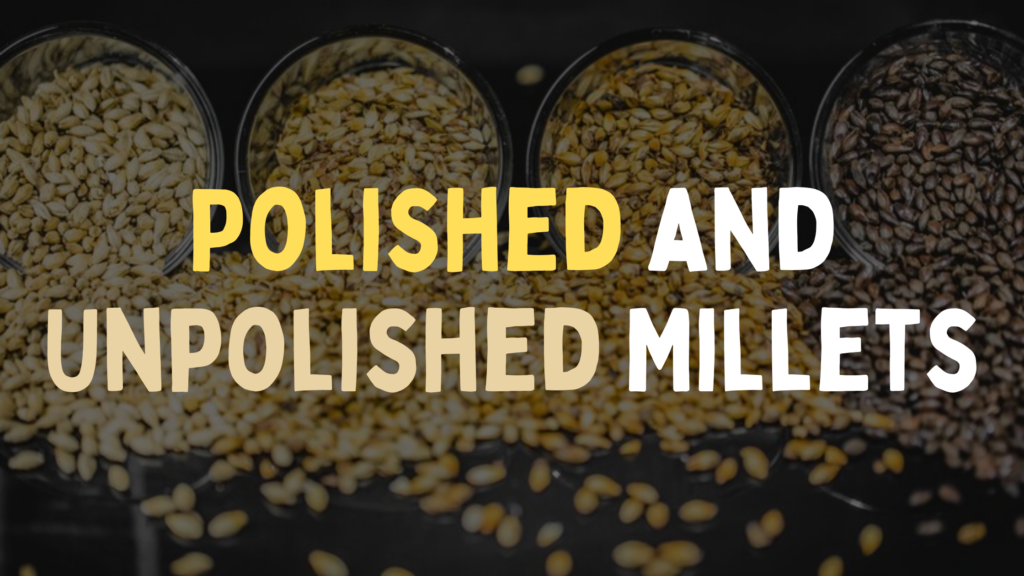
Introduction:
With their many health advantages and adaptability in the kitchen, millets have become a nutritious powerhouse. The argument between polished and unpolished millets is becoming more and more popular as interest in healthier grains grows. We clarify millet flour, explore the subtle differences between polished and unpolished millets, and provide guidance on choosing the best millet product for your nutritional requirements in this extensive guide.

What are Unpolished Millets?
Unpolished millets refer to grains that retain their outermost layer, known as the bran. This layer is rich in fiber, vitamins, and minerals, rendering unpolished millets a nutrient-dense choice. Studies indicate that the presence of bran enhances satiety, regulates blood sugar levels, and promotes digestive health. Unpolished millets are characterized by their earthy flavor and slightly coarse texture, making them ideal for various culinary applications.

What are Polished Millets?
Polished millets undergo a refining process that involves removing the bran and germ layers, leaving behind the starchy endosperm. While this process imparts a smoother texture and milder taste to the grains, it also strips away a significant portion of their nutritional content. Research suggests that polishing leads to the loss of essential nutrients, including fiber, vitamins, and minerals. Consequently, polished millets offer fewer health benefits compared to their unpolished counterparts.

What is Millet Flour?
Millet flour is a versatile ingredient derived from ground millet grains. It serves as a gluten-free alternative to traditional flours, making it suitable for individuals with gluten sensitivities or celiac disease. Millet flour boasts a distinctive nutty flavor and fine texture, making it ideal for baking, thickening sauces, or preparing gluten-free pastas. Furthermore, millet flour retains the nutritional integrity of whole millets, providing a rich source of protein, fiber, and essential micronutrients.
How to Differentiate Between Unpolished and Polished Millets?
Distinguishing between unpolished and polished millets is relatively straightforward. Unpolished millets exhibit a darker hue and rougher texture due to the presence of bran. In contrast, polished millets appear lighter in color and possess a smoother surface, indicative of the refining process. Additionally, reading product labels and opting for organic or whole grain varieties can help ensure you’re selecting unpolished millets.
Which One is Better: Unpolished Millets, Polished Millets, or Millet Flour?
When it comes to nutritional value, unpolished millets reign supreme. Their retention of bran and germ layers translates to higher fiber, vitamin, and mineral content compared to polished millets. Additionally, unpolished millets offer superior satiety and digestive benefits, making them a preferred choice for promoting overall health and well-being. While polished millets may appeal to those seeking a milder taste and smoother texture, they fall short in terms of nutritional value. Explore the different types of millets: Click Here.
Millet flour, on the other hand, presents a convenient alternative for incorporating millets into various recipes. It retains the nutritional integrity of whole millets while offering versatility in culinary applications. Whether you opt for unpolished millets, polished millets, or millet flour ultimately depends on your dietary preferences and nutritional goals.
Conclusion:
In the quest for optimal health, the choice between polished and unpolished millets holds significant implications. While polished millets may offer a smoother texture, they pale in comparison to their unpolished counterparts in terms of nutritional value. Unpolished millets emerge as the clear winner, boasting higher fiber, vitamin, and mineral content essential for overall well-being. As you embark on your millet journey, prioritize unpolished varieties to reap the maximum health benefits.
Are you a fan of millets? Share your thoughts and experiences in the comments below!
